What is Blackwork tattoo style?
History and characteristics of the different sub-styles
20 November 2023
Blackwork is a tattoo style that exclusively uses black ink. It has gained popularity among tattoo artists who prioritize the use of black ink over other colours, and is currently in great demand.
This style is highly versatile, which makes it challenging to explain how to execute it, under which techniques and through what types of designs.
Blackwork tattoos are known for their depth and bold presence, particularly for using large amounts of pure black ink in contrast with shading techniques like Dotwork. These tattoos can range from minimalist to intricate and complex designs.
Achieving a successful blackwork tattoo requires a thorough understanding of composition and balance between filled areas and negative spaces.
To fully grasp what characterises this versatile style and its current impact, we should delve into its historical origins, influences, and cultural significance.
Let's take a journey back in time to explore these aspects.
History of Blackwork
Black ink tattoos have been present since the beginning of this art form, being the first pigment used to permanently mark the skin.
The practice of tattooing has existed for at least 5,000 years, originally having medicinal purposes in early civilizations. Throughout time, they have become part of the identity-building of different communities.
Some historical accounts suggest that Blackwork originated from the Maori tribes in New Zealand and French Polynesia.
"Tattow," as they were known back then, carried profound symbolism and held significance in the social hierarchies of each community, as well as representing ideologies and religious beliefs.
However, it wasn't until 1769 that the Western world first encountered these captivating tattoos when English explorer James Cook travelled to Tahiti.
As with any novelty, it quickly captured the attention and gradually began to spread.
According to historical documentation from the renowned Smithsonian Museum, black ink tattoos initially gained popularity among the working class in Europe, particularly among sailors and coal miners.
From then on, the tradition of black ink tattoos has evolved and diversified into various artistic branches, until finally shaping the style as we know it today.
Characteristics of the Blackwork style
Despite being rooted in tribal influence and designs, there's more to Blackwork tattoos. Such have they evolved over time that today, their characteristics vary depending on the style of the artist who creates them.
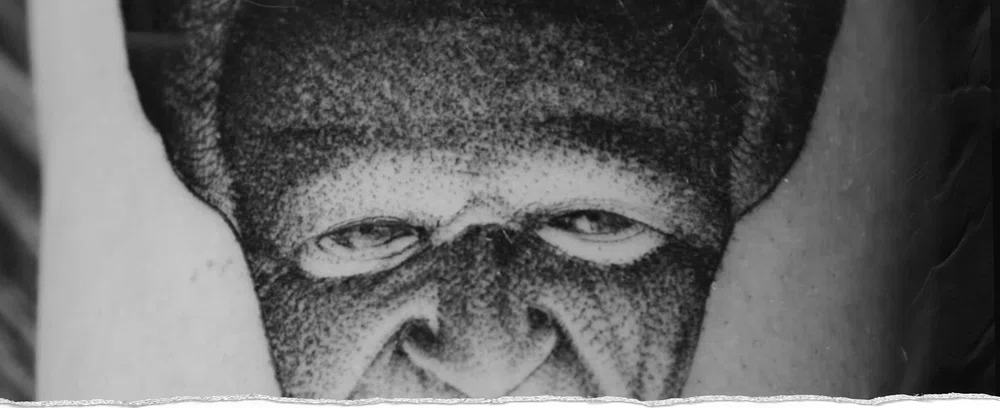
Nevertheless, blackwork tattoos still possess a distinct and easily recognizable aesthetic.
- Black ink is often used for absolutely everything: lines, shading effects, textures, and fillings.
- Generally, there are no dilutions, no Grey Wash, no smooth gradients, and white is barely used or not even at all. Although, there are exceptions. Therefore, it is not immovable and varies according to the artist's technique.
- High contrasts, saturations and skin reserves are usually the main elements.
- Well-defined, precise and mostly thick lines are prioritized.
- Another recurring factor is the stippling technique, whether in pepper shading style, by using dots, lines or cross-hatching. Techniques through which very interesting volume effects can be achieved.
- In any case, it is the two-dimensional design that most characterises it, unlike styles such as Realism, which is three-dimensional.
Blackwork tattoo sub-styles
Blackwork style is characterized by numerous factors. While it originated with both symbolic and abstract patterns, it has now expanded to include a wide variety of elements. All the same, the intentions behind blackwork tattoos have shifted from being protective and sacred to being more focused on aesthetics and self-expression.
From botany, sacred geometry, insects, Gothic art, and even fictional characters... Blackwork style offers endless artistic possibilities as different as unique.
We could describe Blackwork as an open style that allows each artist to find their own unique place and develop their personal artistic signature.
That's why, to provide a comprehensive understanding of Blackwork, we need to explore the different sub-styles that comprise it.
Geometric
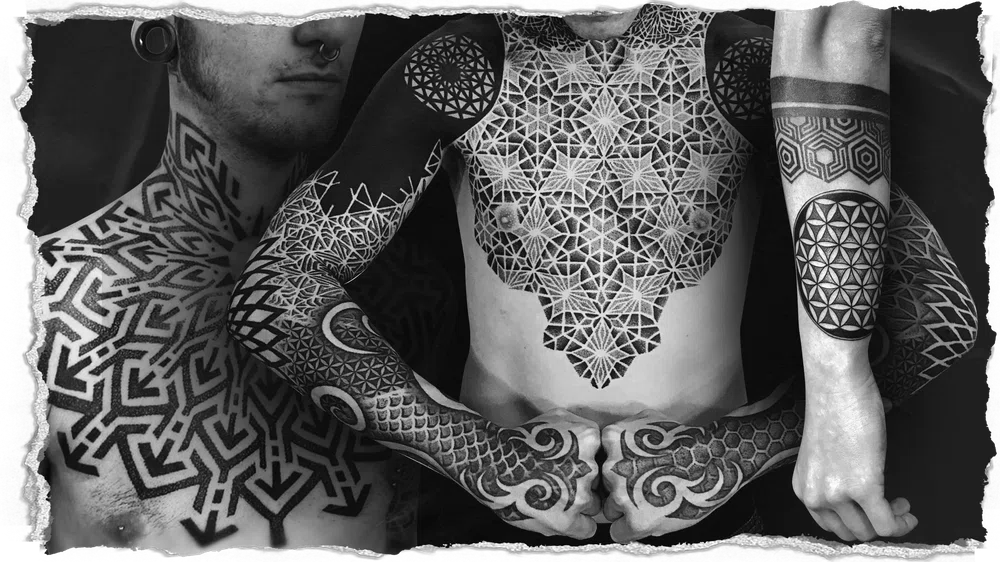
@tomastomas108 ; @brandon_crone ; @ilkimkoctattooer
Influenced by Plato's sacred geometry and Spanish textile embroidery, geometric blackwork tattoos offer intricate and visually captivating designs.
From intertwined patterns that range from purely decorative elements to complex fractals filled with symbolism, this geometric branch of Blackwork has the power to capture the eye of any beholder.
Ornamental

@_samrivers_tattoo ; @dino_vallely ; @raimundo_ramirez
Another geometric sub-style but with a more round and ornamental appearance, draws inspiration from Mehndi tattoos, also known as Henna tattoos.
Symmetry plays a significant role in these tattoos, resulting in organic and symbolic designs.
One prominent example is the mandala, a sacred symbol representing the macrocosm and microcosm in Hinduism and Buddhism.
Botanical
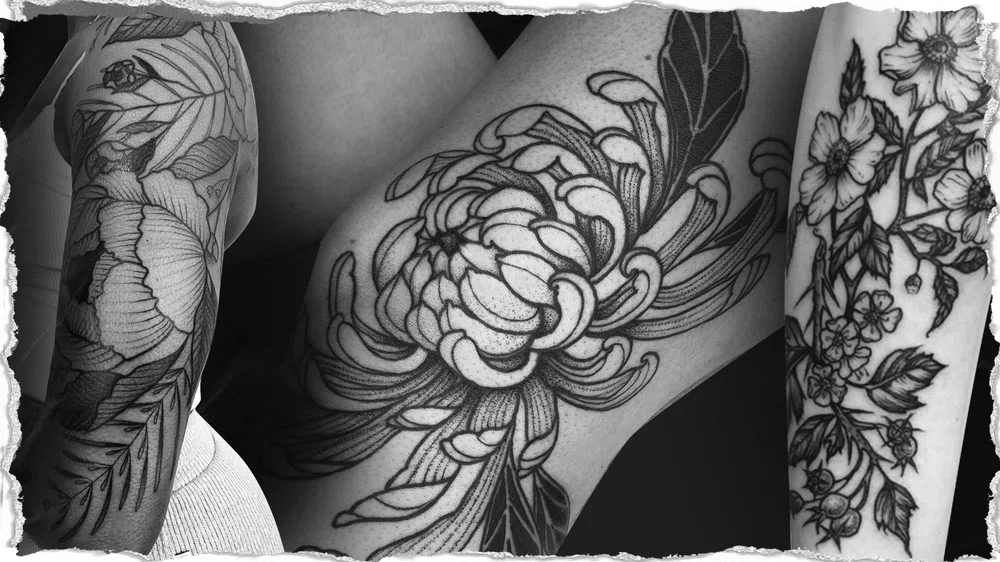
@danielthegardener ; @fede.tattoos ; @rebecadewinterttt
Nature has always been an inspiration for art. Floral motifs are as popular as they are timeless. Whether they are flowers, plants, trees, fruits, vegetables or entire gardens…
These designs range from the most delicate and feminine (or even bordering the Fine Line style) to the most pronounced and solid (as in New School style but without colours).
These designs adapt and flow with any area of the body. They are aesthetic but usually loaded with meaning. And they go well both to star or to complete and unify spaces.
Dotwork
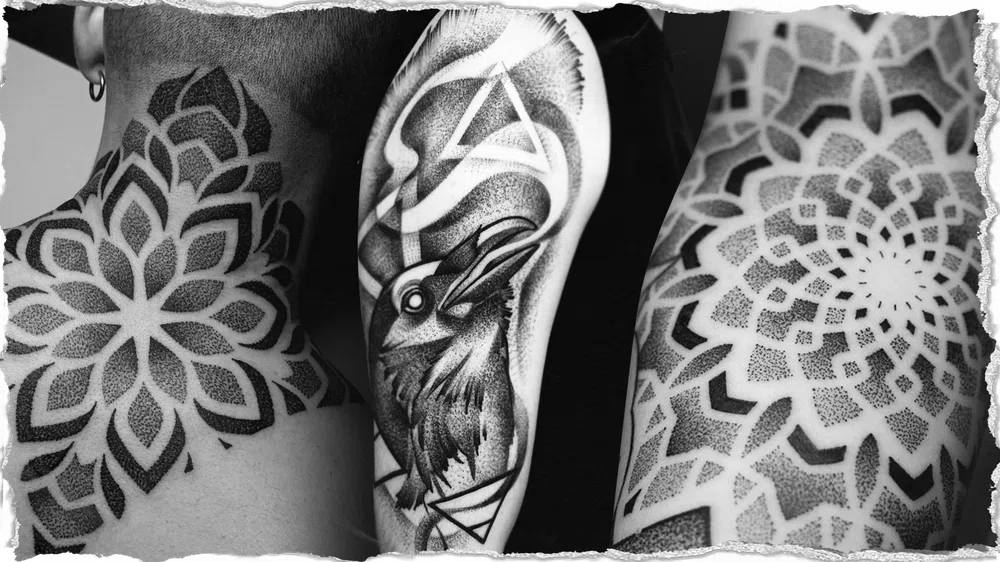
@_ladeh_tattoo ; @suflanda ; @_medvedev_tattoo
Pointillism comes from Impressionism, an avant-garde art movement of the 20th century. It is characterized by creating various effects and shapes based on the arrangement of spots, lines, and dots.
Both drawing and tattooing have embraced the use of dots, lines, and patterns to generate volume, relief, and texture. In this sub-style, lights and shadows are achieved through the quantity, proximity, and distance of these elements.
The shading techniques that make up the Dotwork are varied, so there is no single way to execute it. To learn more about it, have a look at our article Tattoo techniques: Dotwork.
Brush & Splatter
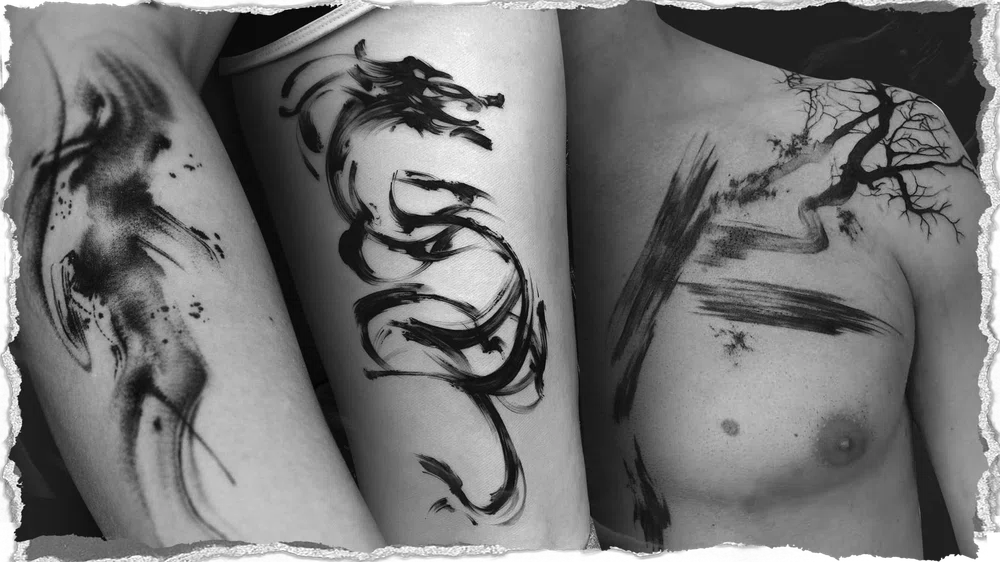
@danzo_tattoo ; @bo.shee ; @polinperhaps
It is a sub-style characterized by loose brushstrokes and splatters reminiscent of Oriental calligraphy or the abstract painting style of Jackson Pollock and his renowned 'Action Painting.'
In tattooing, the execution differs significantly, especially within Blackwork where colours are omitted. Nevertheless, a similar visual effect is achieved, aiming to express fluidity, energy, and a sense of spontaneous movement.
Some artists approach the stencil process creatively by using brushes, their fingers, or occasionally even throwing ink from a distance to fully immerse themselves in the experience.
Sketch
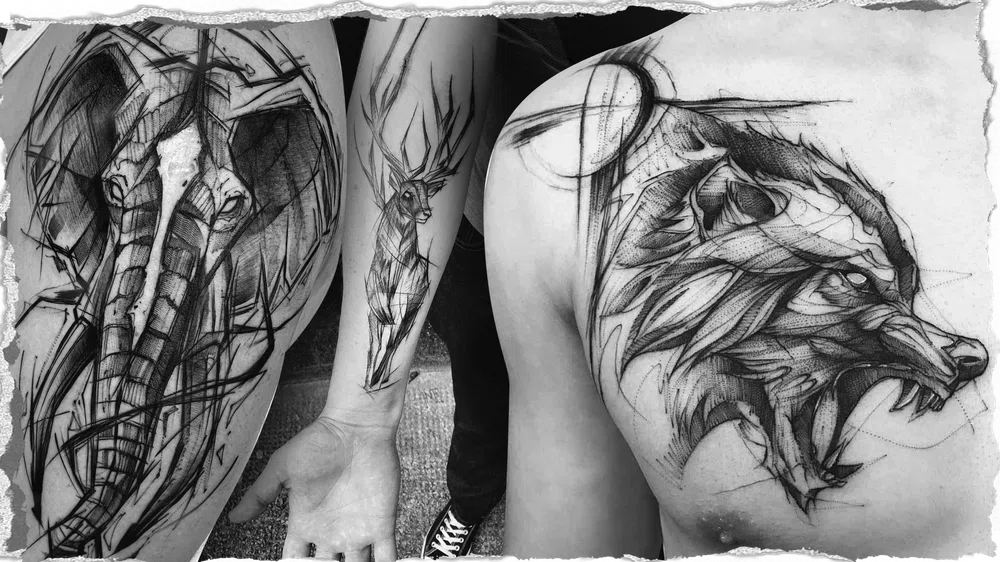
@ineepine ; @bk_tattooer
Another sub-style within Blackwork that aims for a relaxed and spontaneous feel. Its delicate strokes evoke the appearance of a sketch drawing. The irregular lines and unfinished elements create a draft-like effect, as if the sketch was still in progress.
In this style, the pursuit of purity and perfection is not the focus. It is common to see guides or marks indicating perspectives and proportions intentionally included in the final design, contrary to the usual practice of erasing them.
To achieve the desired "pencil" effect, very fine needles, such as those used in FineLine tattoos, are typically employed. However, designs with contrasting thicker lines can also be found.
The intention is to capture the essence of the creative process. And while we are currently discussing Blackwork, this style can also be combined with many other tattooing styles.
Abstract
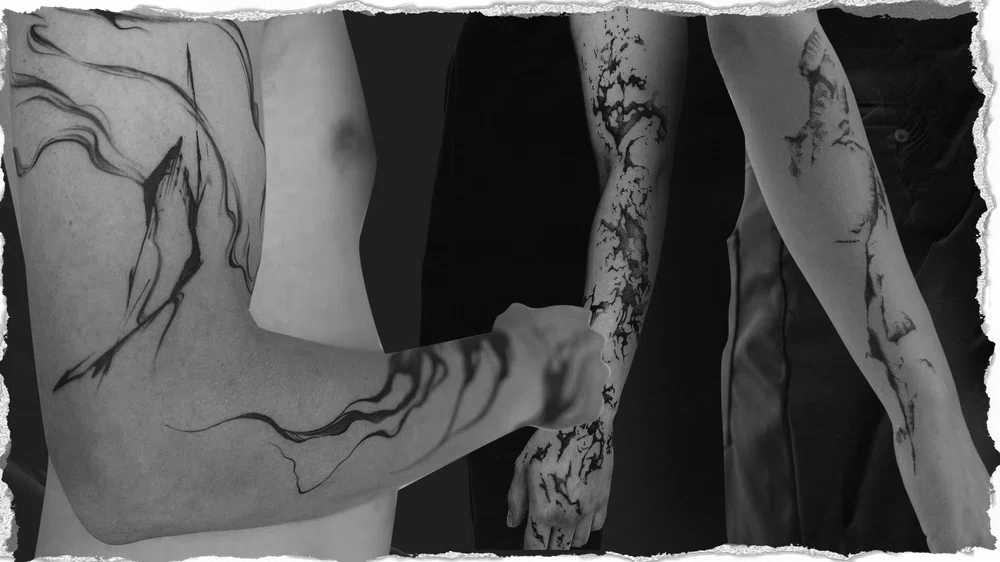
@norte.00
Another non-figurative variation within Blackwork. This style is characterized either by symbolic or purely aesthetic elements; occasionally finding non-so-geometrical designs.
Through the use of lines, fillings, and shapes, many tangible elements such as animals or objects can be expressed in an abstract way. Concepts can also be conveyed to either evoke ideas, sensations, or stories.
It's a non-representational, subjective, and freely interpreted form of art. It varies from artist to artist and lends itself well to be executed in FreeHand.
Oriental

@nos_tattoos ; @goscarhove
Another millennial style that has permeated society since ancient times. The Japanese tattoo also carries a rich cultural, social, and spiritual background.
It's a style filled with symbolism and narratives, easily identifiable by its distinct characteristics and motifs. From a wide range of mythological creatures and folkloric characters to earthly elements.
While colour plays a significant role in Japanese tattoos and influences their representation, due to its two-dimensional perspectives and unique utilization of negative space, they suit Blackwork perfectly.
The most prevalent designs are the four elements of nature, the weather, landscapes, flowers, ornaments, numerous mythological animals, samurai, geishas, skulls, masks, demons, and kanjis (Japanese lettering).
Dark Art
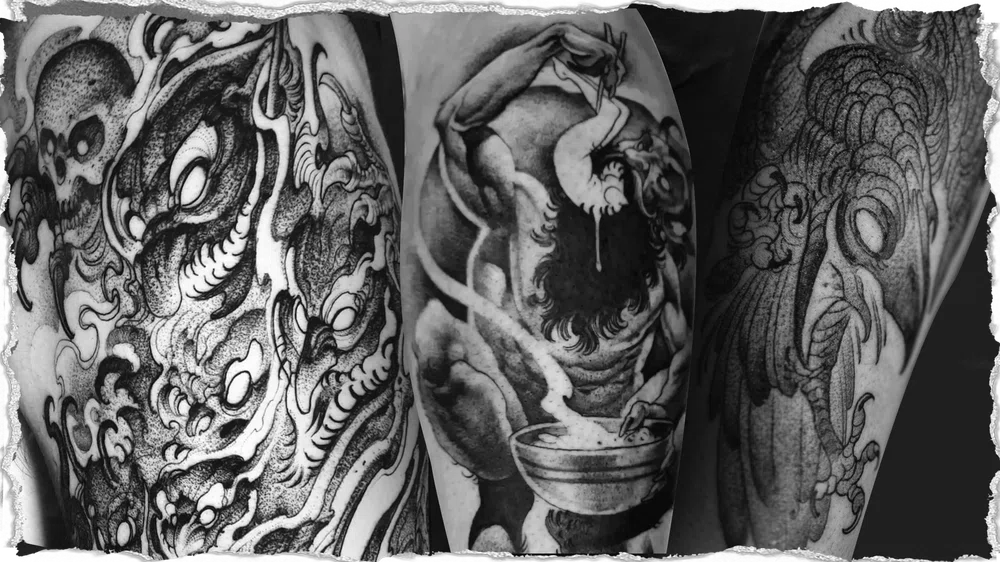
@rebollink
Inspired by engravings, the occult, and mysticism, this stylistic branch of Blackwork is known for its dark, macabre, and highly expressive nature.
It usually portrays the esoteric, strange, disturbing, magical, surreal, fantastic, and the supernatural... It possesses such a strong presence that it may not appeal to everyone and is typically favoured by enthusiasts of dark forces and unexplained natural phenomena.
From a technical standpoint, it is intriguing how these tattoos organically fit different parts of the human body, making it also a suitable style for FreeHand.
Common motifs within this style include many symbolisms associated with witchcraft, classic horror characters, demons, skulls, bats, and anything that exudes a dark aura or can be classified as gothic or 'Halloweenesque'.
Lettering
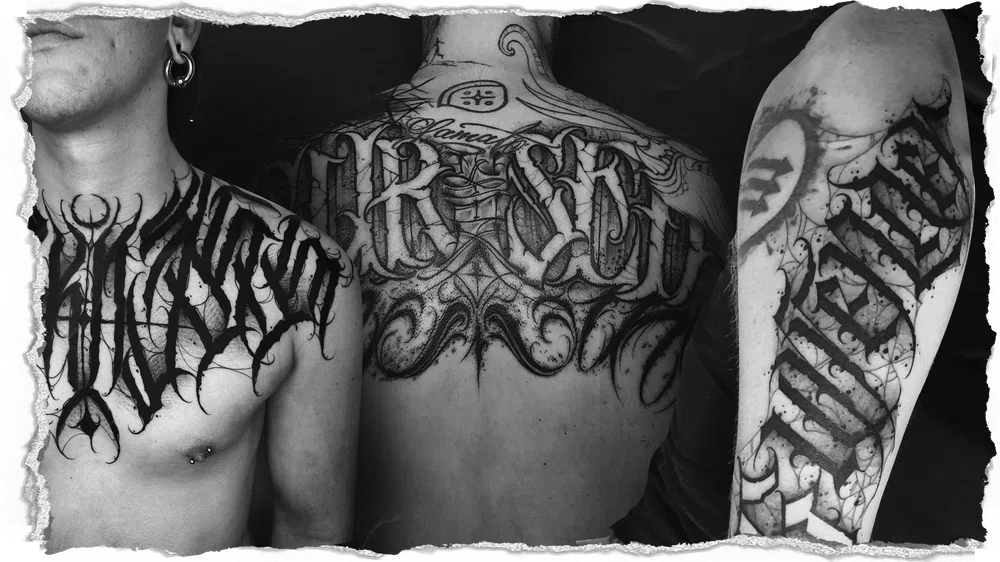
@diegotattoo ; @gromov6666 ; @chriz.letters
Despite gaining popularity in recent decades, this style also has ancient influences. Evidence suggests that ancient Chinese and Japanese cultures adorned their skin with marked lettering.
In present times, the possibilities for lettering are as diverse as the range of calligraphic styles. From simple and delicate cursive scripts to elaborate and intricate letterforms, there is a wide array to choose from.
A lettering can be pigeonholed into several styles, but now we will focus on Blackwork, where the calligraphy is solid, robust and entirely black.
Some have a printing style, others, an engraved appearance. And others are inspired by medieval or gothic calligraphy and are so complex that sometimes it is even difficult to read them.
Special mention: manga, anime, comic and cartoon
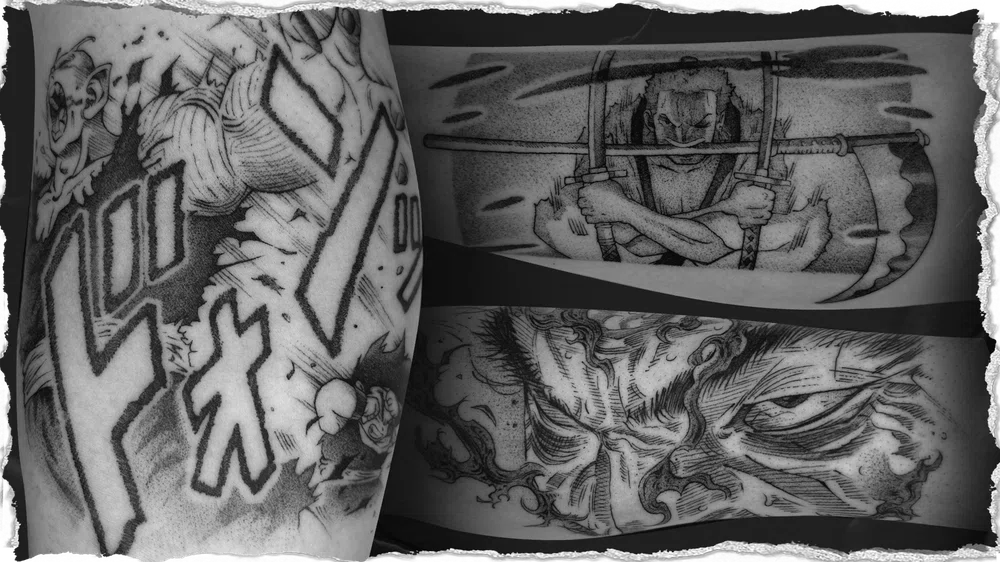
@monlixtattoo
There is a great deal of reverence for comics, manga, and cartoons. So, it is common to come across tattoos that depict specific scenes or characters.
Plus, since black ink not only captivates individuals but also complements any skin tone, within Blackwork we can find an endless number of tributes to these little worlds.
There is so much to dig into, I wouldn't fit it all in. Pass by this article to know more, Manga, anime and tattoos.
Such is the difference between the original styles of each reference that it makes it hard to describe it in a few words. So we better express it with visual examples.
Bonus: New School and Neo-Tradi

@madman_tattoo ; @_annabellemeister ; @leo.branco.tattoo
The same goes for these two highly distinctive and popular styles, they can also be executed entirely in black ink.
They share certain similarities, often leading to confusion. In broad terms, both have the foundational elements of traditional American tattoos, with black lines serving as the framework. However, there are a few differences in terms of techniques, motifs, and intricate details.
If you're interested in delving deeper into these styles, you can explore the following article that outlines the unique characteristics of each one: Neo-Traditional Tattoos, and New School Tattoos.
The great versatility of both styles is most vividly showcased in their coloured versions. However, they also adapt exceptionally well to Blackwork.
Let's take a look at some examples!
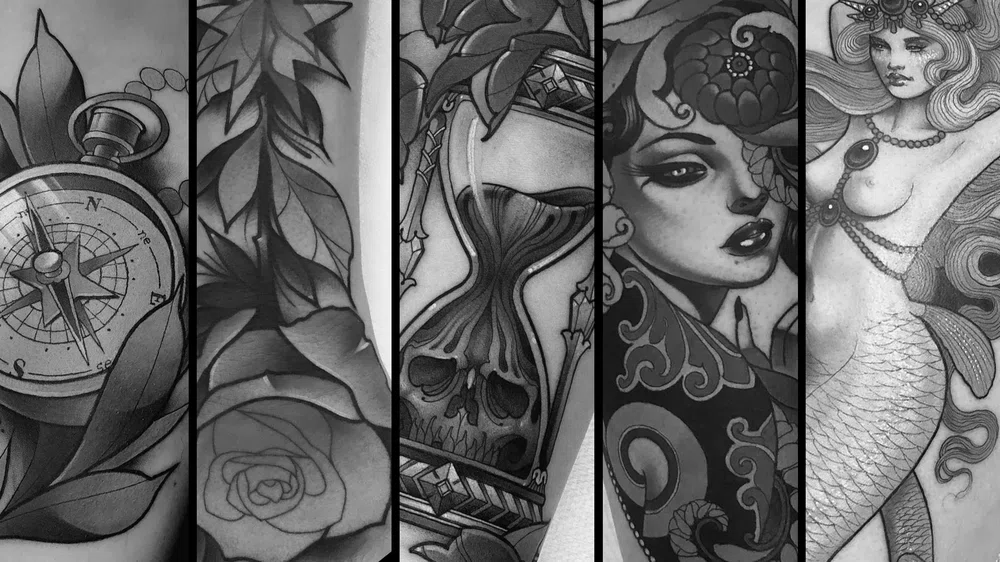
How is Blackwork different from other styles?
When it comes to Blackwork tattooing, it is common to confuse it with others with similar names, such as Black & Gray or Blackout.
But although they share some similarities, such as the exclusive use of black ink or solid fillings, they are not the same, nor are they based on the same techniques.
Let’s briefly see why:
¿Blackwork o Blackout?
In Blackout, the goal is to cover large surfaces in solid black, while Blackwork is characterized by the high contrast of solid fillings and skin reserves.
Besides, the techniques and needles used in Blackout are more invasive to the skin compared to those used in Blackwork.
The same goes with its uses, as blackout tattoos are typically used as cover-ups, aiming to conceal previous tattoos. On the other hand, Blackwork tattoos are commonly sought after as unique designs, although it is common to encounter blackwork blast-overs as well.
¿Blackwork o Black and Gray?
Some say that Black and Gray is actually a spinoff from Blackwork, but this is not entirely true, since there are many differences in both design and execution.
The first uses Gray Wash to dilute black inks and achieve other effects, both for shadows and to generate depth and detail. Additionally, it often incorporates watercolor techniques and is commonly used in realistic tattoos.
Whereas in Blackwork, pure solid blacks prevail and precision in the strokes becomes crucial since the use of ink does not allow for as many passes over the same surface as Black & Gray does.
On the other hand, in Black and Gray, apart from expanding the range of blacks using thinners, white ink is always used to highlight details and add volume. While in Blackwork, black is prioritized, and white is generally not applied. However, you should know that this last point is not a law, as there are artists who do incorporate it to a certain extent.
So, should one specialize in Blackwork style ?
Blackwork is indeed a wide, flexible, and permissive style. We could say that it's ideal for artists who desire to specialize in a style that doesn't confine them too narrowly.
However, this freedom also has its drawbacks...
In a way, it can be a double-edged sword, as, among the many possibilities and versatility, effective communication with clients, while establishing a strong dialogue to understand and fulfill their expectations becomes crucial. Let alone how it can get in between your decisions on how you want your art to be.
A good way to find it out is by exploring your personal preferences and trying until discovering what works best for you. Have you read this article yet? How to achieve your own style in tattoos? It may provide useful insights.
As important as having a thorough understanding of tattoo machines and their components may be, in Blackwork style, it becomes absolutely crucial to know the optimal depth and proper technique to prevent blowouts or, by contrast, to avoid the pigment remaining too shallow.
When working with pure black ink, one has to be very precise when pricking the needle, which is difficult to achieve.
Still, Blackwork is an incredibly advantageous style for artists in terms of supply investment, creating original designs, and practicing techniques that are both intriguing and demanding.
So, if you are fond of this aesthetic and feel a natural affinity for it, give it a try and unleash your creativity, as Blackwork is ideal for it.
Interested in learning more about this style and all the techniques that distinguish it? We teach you everything in our NEW MasterCourse: Blackwork Tattooing with Rebollo.